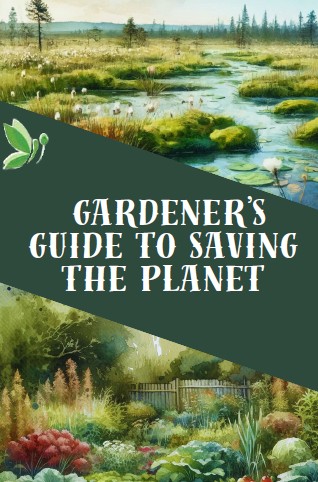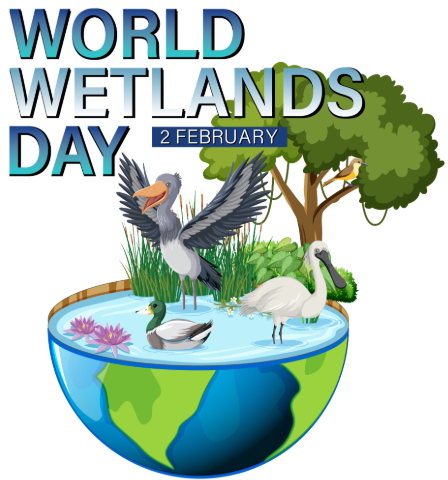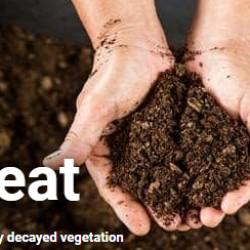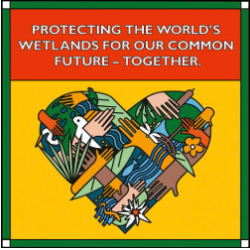For Peat’s Sake, Don’t Use Peat!
Here’s some interesting information, at the time when you might be purchasing peat, peat pellets, and peat pots etc. for your upcoming Spring Chores. I chanced upon an article in the BC Council of Garden Clubs bulletin and it led me down a rather long investigation to do with our Peatlands. There is a wonderful new book by the Peatland Protection Society, based here in BC.
The following is taken from the article I published in my local newsletter. I hope it will inspire you to consider peat alternatives when possible.
“The Gardener’s Guide to Saving the Planet”

Authors: Eliza Olson & Seppideh Saatchi
Publisher: Peatlands Protection Society
(website in progress)
In my quest to understand at least some aspect of the catch-phrase “For peat’s sake, don’t use peat!” I contacted the Peatlands Protection Society. I was delightfully surprised to receive an immediate response from co-author Eliza Olson. She quickly made me aware that the preservation of peatlands needs a lot more public attention as well as immediate governmental policy changes. Other countries have already begun to implement restrictions.
The book, “The Gardener’s Guide to Saving the Planet”, is not only informative, but very interesting to read! It offers straight-forward explanations of what peatlands are, why their preservation is so important to their unique environment, and how they are part of the solution to climate change. Additionally, there are useful tips for gardeners on simple changes they can make to actively combat peatlands desecration. You might even explore creating your own bog or moss garden. Here’s a fun bonus: there are recipes at the end of each section! You can read a lovely book review in the BC Council of Garden Clubs Dec. Bulletin. https://bcgardenclubs.com/wp-content/uploads/bulletins/2024/bulletin-2024-12.pdf
Single books: $29.95 +5%GST=$31.45 + $5.00 shipping & handling unless picked up at the society’s office in Delta. Cheques and e-transfers are available for payment. Proceeds go to the society’s education programs.
To order the book or for more information contact: peatlands@peatlandsprotectionsociety.ca Eliza Olson, LLD.,(h.c.), B.Ed.
Some of the points Ms. Olson mentioned in our emails were:
*Some peatlands are up to 50,000 years old. Dr. Maria Strack estimates it takes 1,000 years to get a damaged/extracted peatland back to its original state and at least 100 years to get it fully functioning.
*Manitoba is the only Canadian province that has any legislation protecting our peatlands. (Manitoba has more peatland – and consequently more soil carbon storage – than any other Canadian province.)
*The River-Fish Cree in Manitoba recently got funding from several places to buy extraction licenses. The Cree have no plans to extract peat but to return it to its natural state for hunting, gathering food and plants for medicinal uses.
*The UK ended the sale of peat for gardening either last year or this year. A few years ago, Kew Gardens was 98% peat-free and planned to be completely peat free by last year. King Charles III stopped using peat in 1988. (Eliza send two copies of her book to HRH as a token of her appreciation for his discontinuing peat in his farming practices.)
* Ireland hasn’t outright banned extracting peat. They put in several restrictions preventing the burning of peat. Bord Na Mona set up to hire unemployed Irishmen to extract peat no longer do any extracting.
* West Coast Seeds in Ladner doesn’t use peat. David Hunter and the Garden Centers in Burnaby sell coir. There is the original Sea Soil without peat. I’ve had one or two people raise concerns about where they get their dead fish—fish farms. On the other hand, what better place to use them if sufficient preparation steps are taken.
Ms. Olson also pointed out some other information.
Inside Climate News: Virginia’s Great Dismal Swamp Peatland Restoration
This webpage explores a huge bog area in Virginia. It states: “…What was once a vast carbon sink (is now) a net emitter of carbon. According to recent research, the Great Dismal Swamp has released an estimated 183 teragrams of carbon dioxide equivalents since the late 1700s, the same as driving more than 42 million gas-powered cars for one year.”
* 2023 The Environmental Law Centre Society Report
“Legal or Policy Options to Ban or Limit the Use of Horticultural Peat Moss in British Columbia”
This report states: “The UNEP Global Peatlands Assessment reports that horticultural peat extraction in Canada has disturbed 24,964 hectares of peatland, of which 8,182 have been restored and 2,168 reclaimed. The fact that the industry in Canada takes active steps to restore harvested peatland is commendable and this should be acknowledged and encouraged. However, Professor Maria Strack, the Canada Research Chair in Ecosystems and Climate at the University of Waterloo, has stated that properly restored peatland can restore carbon uptake after 20 years – but “it will take much longer to recapture the carbon that is released when peat is used as a growing medium – probably 100s to 1000s of years.”
The Environmental Law Centre recommendations are:
- The Province of BC should move to ban the sale of horticultural peat moss.
- The Province of BC should create government procurement policies that ensure peat-based products are not procured for horticultural and park services.
- Municipal governments should set local regulatory initiatives to ban the use of peat-based products within their jurisdictions.
- The Vancouver Board of Parks and Recreation should ban the use of peat-based products in city parks and street trees.
- The Province of BC should support point of sale measures to discourage consumers from purchasing horticultural peat.
- The Peatland Protection Society could seek to create a voluntary certification program for garden retailers.
Other institutions have a different perspective which favours the peat industry. They claim that peatlands can be restored within acceptable time frames. This is in conflict with the broader view of peatlands having a more important role in counteracting climate change.
* Peatland Restoration Guide
This guide outlines the research regarding peatland restoration. It is noted that research only started in 1993. Large-scale restorations have not been entirely successful. Some sphagnum dominated peatlands cannot be restored to their natural state. The best success is seen when the restoration methods are determined before the site is actually harvested.
https://tourbehorticole.com/wp-content/uploads/docs/Peatland_Restoration-e.pdf
* CSPMA Canadian Sphagnum Moss Association
and PERG Peatland Ecology Research Group
Research on the management of peat as a resource has been ongoing since 1992. They state that sphagnum moss coverage can be re-established within three to five years. They also state that it takes 10 to 15 years following restoration for the site to capture carbon to levels equivalent to natural peatlands.
Here is the other part of my article.
World Wetlands Day – “For Peat’s Sake”
What might a gardener write about in February, excluding the obvious theme of “Valentine’s Day” plants? Checking out seed catalogues? How about the easy-peasy use of “peat pellets” for starting seeds? Here’s a surprising, and rather alarming, catch phrase: “For peat’s sake, don’t use peat!”
February 2nd marks “World Wetlands Day”. The “Convention on Wetlands”, supported by 172 countries, was adopted in 1971. Our BC Council of Garden Clubs recently had a timely review on a new book, “The Gardener’s Guide to Saving the Planet”, published by and purchasable from the Peatlands Protection Society (affiliated with the West Coast Climate Network), which started me investigating the question of whether using peat, a common garden purchase, is not as benign as we thought.
What are Peatlands? The International Peatland Society defines them as terrestrial wetland ecosystems. When waterlogged plant matter is unable to fully decompose, the resulting material is peat. Sphagnum mosses and shrubs are the predominant vegetation in cool climates, and graminoids (mostly grasses) and woody vegetation are in warmer climates. Eliza Olson (Peatland Protection Society) states that some peatlands are up to 50,000 years old. Dr. Maria Strack, University of Waterloo, estimates it takes 1,000 years to get a damaged/extracted peatland back to its original state and at least 100 years to get it fully functioning.
Peatlands (almost half of the world’s wetlands) store twice as much carbon as all the world’s forests and yet cover only 3% of the planet’s land, according to the UN Environmental Program. When drained or burned, they go from being carbon sinks to carbon sources. They take centuries to redevelop, and they also are a unique ecosystem supporting numerous wildlife. UN Environment Peatlands experts claim that since 1970, we have lost 35 percent of them.
Peat is still used for heat and power in some countries, notably Ireland, Finland, and Sweden, but environmental concerns have now been raised. For example, only about 20% of Ireland’s peatlands remain intact! They have now put in restrictions preventing the burning of peat and some extracting has been curtailed.
It may seem that our little gardens don’t make much of a difference, but, for example, the UK has recently ended the sale of peat for gardening. The famous Kew Gardens are already 98% peat free! The International Peatlands Society states that Canada and Germany account for about half of the world’s horticultural peat extraction. Most of the peat moss used in the USA comes from Canada’s sphagnum bogs! (Ouch!) SunGro Horticulture, a leading exporter of Canadian peatmoss, claims to only harvest from bogs which are suitable for restoration. Research on restoration is being done by the Peatland Ecology Research Group to “re-establish a plant cover typical of sphagnum peat bogs, which will allow the long-term peat accumulation function to be re-established”. Hmmm… but after this plant cover grows, doesn’t creating the peat layer (which actually absorbs the carbon) still take hundreds of years? (That’s just my personal understanding of this complex subject!)
There are peat-free compost alternatives, but you must check carefully. “Organic” does not mean peat-free. Farmers Almanac suggests 7 alternatives: Coconut Coir, Wood-based materials, Compost, Pine Needles, Rice Hulls, Leaf Mold, Composted Manure. Other websites additionally list: Sand, Bentonite Clay, Expanded Clay, Perlite, Xylit. (My note: Some websites warn that Coconut Coir is not the “perfect solution” as it may have additional issues of its own.)

The World Wetlands Day 2025 theme is “Protecting Wetlands for Our Common Future”.
It seems we are losing wetlands three times faster than forests.
On February 2nd, check the labels on your own supplies
and see if your next purchases can be peat-free.
World Wetlands Day
World Wetlands Day
https://www.worldwetlandsday.org/about
Convention on Wetlands (supported by 172 countries)
https://www.ramsar.org/about/our-mission/importance-wetlands
Book Review and purchasing info
“The Gardener’s Guide to Saving the Planet”
BC Council of Garden Clubs – December Bulletin with the book review and information on purchasing “The Gardener’s Guide to Saving the Planet”
BCCGC December 2024 Newsletter PDF3
Information on Peat, Peatlands, and Climate Change
International Peatland Society – What is peat? Wath are peatlands?
What is peat? – International Peatland Society
https://peatlands.org/peatlands/
Wikipedia – general information on Peat
https://en.wikipedia.org/wiki/Peat#Formation
IPS – International Peatland Society
https://peatlands.org/peatlands/
West Coast Climate Action Network
Position Statements | West Coast Climate Action Network
Note: the Peatlands Protection Society is currently developing its own website
UN Environmental Programme
https://www.unep.org/news-and-stories/story/peatlands-store-twice-much-carbon-all-worlds-forests
EPA Environmental Protection Agency
https://www.epa.ie/publications/research/climate-change/research-401-peatland-properties-influencing-greenhouse-gas-emissions-and-removal.php
SunGro Horticultural – a leading exporter of Canadian peatmoss
(promoting the sale of peat as it considers itself a responsible peatland harvester )
https://www.sungro.com/about-us/sustainable-practices/
https://www.sungro.com/wp-content/uploads/SG-Bog-to-Bag-Download-PDF_061820.pdf
Alternatives to Peat
Farmers’ Almanac – 7 Peat Moss Alternatives
https://www.farmersalmanac.com/peat-moss-alternatives
Niab is a leading UK crop science organization
https://www.niab.com/news-views/blogs/alternatives-peat-horticulture
Gardender (a community-based blog) – 11 alternatives to Peat
https://gardender.com/peat-substitutes/
Plantura Magazine – 11 alternatives to Peat
https://plantura.garden/uk/gardening-tips/soil/peat-alternatives
Food Gardening Network – Peat-Free vs Peat-Based Compost
https://foodgardening.mequoda.com/daily/composting/peat-free-vs-peat-based-compost-which-is-better/
The Fertile Fiber
https://www.fertilefibre.com/blogs/blog/peat-compost-alternatives
Coco Coir Global
https://cococoirglobal.com/coco-coir-global-sustainability/
PlantBest (a Canadian company)
https://www.plantbest.com/why-coconut-coir
Garden Myths – I just discovered this very interesting website!
Excerpt from the website https://www.gardenmyths.com/
”The author of most posts, Robert Pavlis, has 50 years of gardening experience, is an award winning author of 11 gardening books, holds an M.Sc. in chemistry and biochemistry, teaches numerous gardening courses and has written articles for many popular magazines such as Mother Earth News.
Robert has just won the Independent Publisher Book Award for Science with his book, Plant Science for Gardeners.
Our Guarantee:
* The information on this site is more accurate than most other gardening sites. If you find an error and let us know in the comments, we’ll correct it immediately.
* None of the information is created by AI – we prefer real people.
* All of the information is science based.
https://www.gardenmyths.com/coir-ecofriendly-substitute-peat-moss/
https://www.gardenmyths.com/peat-peatmoss-true-story/
https://www.gardenmyths.com/peat-moss-alternatives/
A Few Specific Peatlands
Burns Bog Information
https://www.burnsbog.ca/about-burns-bog/unique-ecosystem
Inside Climate News – Virginia’s Peatlands
Irish Peatland Conservation Society
https://www.ipcc.ie/
BBC – How Ireland is Abandoning its Dirty Fuel
https://www.bbc.com/future/article/20201203-peat-the-decline-of-the-worlds-dirtiest-fuel
NASA – Irelands Cutaway Peatlands
https://earthobservatory.nasa.gov/images/150780/irelands-cutaway-peatlands
SunGro Horticultural – a leading exporter of Canadian peatmoss
https://www.sungro.com/about-us/sustainable-practices/
https://www.sungro.com/wp-content/uploads/SG-Bog-to-Bag-Download-PDF_061820.pdf


Recent Comments